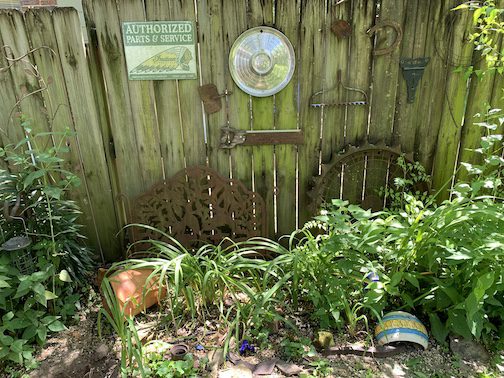
By Sharron Johnson
July is synonymous with vacation time, Independence Day, and hot, humid Memphis weather. It’s also synonymous with gardening, but then I bet you knew I was going to say that!
In Memphis, we can tout ideal growing conditions compared to many places. A long season helps gardeners reap more edible crops as well as flowers. This year I was able to get the tomatoes in the ground early because the weather warmed up at the end of March. Thus, I was able to have the first tomatoes on the first of June. I put out eight plants and have a bushel to enjoy thus far. Most food crops need at the very least six hours of direct sun daily. One inch of rainfall per week is optimal and hopefully not all at once. Why? Too much water at once causes tomatoes to split their skins. If you must water to supplement, do so on the ground, not the foliage. The leaves don’t fare well with the chlorine and fluoride that Memphis adds to the water. I don’t fertilize my garden patch with commercial products. I use compost mixed into the soil before I add the plant starters. Seeds in the ground never survive my dogs tromping around. When I put the plants into a wide and deep hole, I bury the plant to almost the top leaves. Say my plant is six inches tall, I’ll leave one or no more than two inches exposed. Why so deep? Well, a tomato will root at any area of its stem. This makes way more roots for a sturdier plant. Better roots, better production. I’m not diligent about pinching suckers to make bigger fruits. I prefer more tomatoes. A sucker is a stem that emerges between the main stem and a leaf cluster. They normally don’t produce fruit but they can be pinched out and inserted into soil and will start a whole new plant that will produce. By doing this, you will keep a fresh crop of plants that will produce fruit up until first frost. Inevitably I will lose a plant or two to dogs, squirrels, or pests. It’s nice to have a new plant to plop right in. Stone Soup produces compost continuously. I freely give it away to our community. If you’d like a few five-gallon buckets full, come by Stone Soup and ask for me, Sharron.

Our Yard of the Month for June is Christine Conley. Residing in a house that was built in 2001, 998 Philadelphia is the site of a quaint composite cottage sporting a gray Hardie board siding. Twin gables with a single window in each help this new home blend in like a chameleon in a forest. There is a small front porch that has been screened in for pest free evenings sitting with friends and neighbors. I’m pretty sure I’ll need one of those in the future. I really like that porch.

The front garden is brand new and replaces a mature one that was filled with non-native plants. Now it boasts small, native sun lovers. In three years this garden will be filled to the brim with butterflies and blooms. This is an east-facing garden with a three-foot dogwood sapling offset from center. There are flagstone stepping pads so as not to disturb young plants. The entire space is edged with red bricks tipped in the ground creating a sawtooth effect. A short black wire fence encases the new bed to keep everything and everyone in its place. A pink hydrangea acts as a pendant on a choker at the porch’s edge to anchor the look. There are found pieces — statues and interesting concrete creations — artistically placed for cohesion. One of my favorite details is the use of vintage tin ceiling tiles used on the bottom section of the screened porch.
Around the back a wooden fence is adorned with interesting rusty iron skillets and sun-shaped hangings. At ground level is flagstone that acts as a walkway and then a patio that contains a quaint, white, wrought-iron table and chairs ready for a shady morning with coffee. The entire perimeter of the back garden is chock full of blooming flowers such as echinacea, crocosmia “emberglow” and ninebark (physocarpus opulifolius or “summer wine”).
Artfully placed throughout are pieces such as a vintage candelabra. Tiny pathways meander through the plantings. The back of the garden has dense shade, mainly from a mature Leyland cypress keeps all the shade lover plants content. A sweet she-shed painted yellow with white trim turns this garden into a fairy tale setting. Rounding out the garden is a mature crepe myrtle acting as a parasol for more semi shade loving plants. I was smitten with Christine’s Mexican hat plant. A circular patch of wild grasses gives a cozy touch and a place to rest the eye. Bird houses, ewers, metal panels, and birdbaths are only a drop in the bucket to how much careful, planned, and sought out art that completes the overall design only to play second fiddle to the flowers. I thoroughly enjoyed my tour. Oh, she has the most precious garden journal filled with sketches of the entire garden to boot.

Christine, tell the readers about yourself. Are you a native Memphian? If not, where do you hail from?
I was born in Pittsburgh and raised in the Chicago area.
Are from a large family? Kids? Partners in crime? Are they gardeners as well?
One sister, Melinda, who followed in my parents’ footsteps and gardened long before I did. I have two wonderful sons, Ben and Joe. Ben has recently become interested in gardening and especially in native plants, as I have.
How long have you been in Cooper-Young and why did you move here?
I moved into CY in 2002. I had been renting in Central Gardens when a friend convinced me that I should look for a house. CY is where I wanted to go because of the charm of unique houses with artsy touches, lots of greenery, stores and restaurants within walking distance, and that general good CY vibe. I didn’t think I could afford it, but with the help of the Cooper-Young Development Corporation, I got my little house. I love living in a neighborhood where I can walk to the bookstore, restaurant, or record store and be entertained the whole way by the color, art, and detail of all the houses and gardens.
What was your garden like when you moved in?
My house was built on a vacant lot. The previous house had been razed after a fire. So, although they did a little landscaping (holly bushes and nandina around outside of house and grass seed sprouting throughout the rest of the lot) there was really nothing here. And although I am forever indebted to the CYDC, I must say I was dismayed to find that any good topsoil had been scraped away.
What is your profession?
I am a retired adjunct professor of art. Taught art mostly at Ole Miss but also at U of M and the Memphis College of art. Drawing was my main focus, although I also taught everything from painting and art appreciation to “Art as Autobiography” and “Art Since 1945.”
Tell us about your hobbies and passions?
I have become passionate about native plants. Doug Tallamy’s talk at the 2018 Cooper-Young Garden Walk felt like a clear call to action. Besides habitat loss, the proliferation of exotic plants is primarily responsible for a startling decline in native animals. In general, regional pollinators don’t recognize non-native plants as food. If there are fewer insects or caterpillars, there’s not enough for the birds to eat. Tallamy gave the example that during the 17 days it takes for chickadees to fledge, the adult birds feed them from 6,000 to 10,000 caterpillars! An oak tree hosts over 500 species of caterpillars, while on a scale of 1 to 10, where 10 is the best at hosting caterpillars, one site said a crepe myrtle is at best a 0.5! That’s right. Crepe myrtles are not native to our area! How did we not know this? Black capped chickadees need 70% native plants in their habitat to sustain their numbers. I was converted. I love birds. I had my crepe myrtle dug up and then planted a (mostly) native garden bed in front of my house. Lichterman Nature Center’s yearly native plant sale was a great help in getting me restarted. And my son, Ben is a recent convert to the native cause, too, so it’s even more fun. A native plant finder site: https://www.nwf.org/nativeplantfinder.
I have also ordered a butterfly cage to help raise monarch butterflies so all those hungry birds don’t eat up all the monarch caterpillars. Ben got me interested in this. This year, for the first time in a few years, the number of eastern monarchs has risen “dramatically” instead of the shocking decline of the previous 20 years. Numerous milkweed restoration projects are thought to have helped this increase. But the western monarchs are still in serious danger. Insecticides and herbicides such as neonicotinoids pose threats to all monarchs, besides habitat loss. Also, more than one-third of North America’s native bird species are at immediate risk of extinction.”
I also love to make music. I sing and play guitar and am learning violin, mandolin and (relearning) piano. We just happen to have a song circle led by my boyfriend, John McDowell, at Stone Soup first and third Saturday evenings. Reading and Sudoku are pleasures. And you could call me a gym rat — 4-5 days a week at the good old Kroc Center.
When were you bitten by the gardening bug?
I just started gardening when I moved into my house in CY. Starting here with a blank slate was a challenge. Also, it was and is the first house I owned.
How would you describe your garden style?
Free Spirited Gardening was the name of the first garden book I bought. I think that was me. Now I would have to say “free spirited native gardening.”
What are your favorite plants, and are there any pass along from a special person?
You will not be surprised to learn that my favorite plants are natives. Some of them are: milkweed, passion flower vine, phlox paniculata “Daughter of Pearl,” Mexican Hat, Cardinal flower, false blue indigo, stokes aster, beardtongue, trumpet honeysuckle, coreopsis “enchanted Eve,” and echinacea “Hot papaya.” Passion flower and bristly buttercup were some of the natives given to me. I hope to pass along many of these.
Do you have any advice for a new gardener?
You guessed it: plant natives. Besides the website mentioned above, I’ve found the Lady Bird Johnson Wildflower Center and the Missouri Botanical Garden sites to be very helpful.




